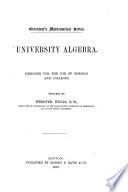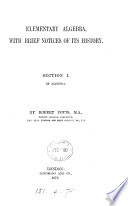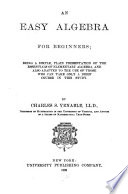 | Edward Atkins - 1874 - 426 pages
...obtained to the first term of the root, and also to the trial divisor, to obtain a complete divisor. 4. Multiply the complete divisor by the second term of the root, and subtract the product, as in long division, from the terms brought down. remainder by the new trial divisor, to obtain the... | |
 | Edward Atkins - Algebra - 1875 - 152 pages
...obtained to the first term of the root, and also to the trial divisor, to obtain a complete divisor. 4. Multiply the complete divisor by the second term of the root, and subtract the product, as in long division, from the terms brought down. 5. If there be any remainder or more terms to bring... | |
 | Edward Atkins - Mathematics - 1876 - 378 pages
...obtained to the first term of the root, and also to the trial divisor, to obtain a complete divisor. 4. Multiply the complete divisor by the second term of the root, and subtract the product, as in long division, from the terms brought down. 5. If there be any remainder or more terms to bring... | |
 | Webster Wells - Algebra - 1879 - 468 pages
...of the root. Add to the trial divisor three times the product of the first term by the second, and the square of the second term. Multiply the complete...root, and subtract the product from the remainder. If there are other terms remaining, consider the root already found as one term, and proceed as befoee.... | |
 | Robert Potts - 1879 - 668 pages
...его» so this divisor 2a by +b, the second term of the root, and multiply the divisor so increased by the second term of the root, and subtract the product from the new dividend, and the remainder is zero. * It maybe noted that 10°, 101, 10", 10s, . . . 10"-1 denote... | |
 | Robert Potts - Algebra - 1879 - 672 pages
...Increase this divisor 2д by +b, the second term of the root, and multiply the divisor so increased by the second term of the root, and subtract the product from the new dividend, and the remainder is zero. * It maybe noted that 10°, 101, 10я, 10», . . . 10"-1 denote... | |
 | Webster Wells - Algebra - 1880 - 498 pages
...of the root. Add to the trial divisor three times the product of the first term by the second, and the square of the second term. Multiply the complete divisor by the second term of the root, nd subtract the product from the remainder. If there are other terms remaining, consider the root already... | |
 | Charles Scott Venable - Algebra - 1880 - 168 pages
...this second term in the root, and to the right of the divisor. Multiply the divisor, thus increased, by the second term of the root, and subtract the product from the dividend. 94. If the root contain more than two terms, a like process continued, doubling each time... | |
 | James Bates Thomson - Algebra - 1884 - 334 pages
...adding to it three times the product of the first term by the second, also the square of the second. Multiply the complete divisor by the second term of...root, and subtract the product from the remainder. IV. If there are more than two terms in the root, for the second trial divisor, take three times the... | |
 | Benjamin Adams Hathaway - Arithmetic - 1885 - 190 pages
...found, and also the square of the second root ; their sum will be the true divisor. Multiply the true divisor by the second term of the root, and subtract the product from the dividend, annexing to the remainder another period as before. Square the whole root as before, multiply... | |
| |